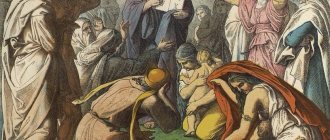The story of the exodus of the Jews from Egypt under the leadership of the prophet Moses is known to almost every person, even non-believers. Recently, with the development of archeology, many Orthodox theologians have questioned some elements of this story.
For example, the head of the department of biblical studies at St. Petersburg University, Anatoly Alekseev, in his report “Archaeology and the Biblical Text” at the theological conference Modern Biblical Studies and the Tradition of the Church, doubts that 600,000 men on foot came out of Egypt.
At the same time, the theologian does not question the very fact of the exodus of the Jews from Egypt.
The Exodus of the Jews from Egypt is a biblical story described in the Old Testament in the book of Exodus
Exodus (Hebrew Yetsi'at Mitzrayim) translated from Hebrew means “exit from Egypt.” This is a biblical story about the enslavement of the Jews or Israelites in Egypt.
It also tells about their mass exodus from the country at the will of God under the leadership of the prophet Moses.
In addition, the legend also tells about the appearance of God to them at Mount Sinai, the conclusion of a covenant (agreement) between God and the chosen people, as well as how the Jews wandered before they began to conquer Canaan.
"Exodus from Egypt" Richard Dadd. 1849 - 50 years. The exodus of the Jews from Egypt is their flight from Egyptian captivity to the Promised Land. Photo: ja-tora.com
The tradition is set out in the Bible, in the Pentateuch, mainly in the Book of Exodus, chapters 1 - 15. Both secular and religious researchers are still arguing about the degree of historicity of the events of the exodus, the possible date, circumstances and interpretation of the episodes of the tradition that the Old Testament narrates.
Moreover, the Great Exodus of the Jews from Egypt is the foundation of Judaism. In Christianity, this is also a very important plot that influenced the theology of some movements, for example Protestantism.
People's anger
After some time, the people of Israel attacked Moses with anger because they did not have enough bread and meat. Moses reassured them and assured them that they would eat meat in the evening and be satisfied with bread in the morning. In the evening, quails flew in, which could be caught by hand. And in the morning manna from heaven fell, like frost, it lay on the surface of the earth. It tasted like a cake with honey. Manna became their constant food, sent by the Lord, which they ate until the end of their long journey.
At the next test stage, they did not have water, and again they attacked Moses with angry speeches. And Moses, by the will of God, struck the rock with his rod, and water came out of it.
A few days later the Amalekites attacked the Israelites. Moses told his loyal servant Jesus to choose strong men and fight, and he began to pray on a high hill, raising his hands to the sky, as soon as his hands dropped, the enemies began to win. Then two Israelites began to support the hands of Moses, and the Amalekites were defeated.
The Israelites settled in Egypt due to famine
The biblical story of the exodus of the Jewish people from Egypt begins with the fact that the shepherd family of Jacob-Israel, fleeing the famine that struck Canaan, left this land and moved to live in fertile Egypt.
The fugitives settled here in the land of Goshen (now Tumilath) (Gen. 46:6). The son of Jacob, Joseph the Beautiful, thanks to his abilities, became an adviser to Pharaoh and became related to representatives of the local aristocracy.
"Israel in Egypt". Painting by Edward Poynter 1867. In order to reduce the number of Israelis living in Egypt, the new pharaoh ordered them to be sent to hard work. Photo: ja-tora.com
The Bible says that the Israelites lived in Egypt for 430 years (Exodus 12:40). In addition, the Holy Scriptures also tell us that during this time the number of the Jewish people in Egypt increased greatly (Ex. 12:40).
As a result, there were more Israelis in Egypt than there were Egyptians themselves. After the death of the old pharaoh and the ascension to the throne of a new one who did not know Joseph, persecution began against them.
To reduce the number of Israelites in Egypt, Pharaoh ordered the killing of their firstborn sons.
The fact is that the new ruler was afraid of the possibility of a military clash and sent the sons of Israel to hard work, trying in this way to reduce their numbers (Ex. 1:10-11).
It was to no avail. To correct the current situation, he ordered the killing of all babies born to the Israelites (Ex. 1.15-22). During this period, the prophet Moses was born. It was Moses who led the Jews out of Egypt.
Moses being lowered by his mother onto the waters of the Nile. Tyranov Alexey Vasilievich, 1808-1859. In order to save baby Moses from being killed by the Egyptians on the orders of Pharaoh, his mother Jochebed floated him in a tarred basket along the waters of the Nile. Photo: ippo.ru
In order to save the baby from murder, his mother Jochebed put her three-month-old son in a tarred basket and floated him along the waters of the Nile under the supervision of her daughter. Pharaoh's daughter went to the river to swim, saw a floating basket and took it to her house.
Jochebed later entered her service and became the nurse of her own son. Moses grew up and was brought up at the court of Pharaoh, but one day he went out to the Israelites and killed the Egyptian overseer, who was cruelly punishing his fellow tribesman.
Moses
As a result, Moses had to flee Egypt and settle in the land of the Midianites.
Notes
- Werner Keller. “The Bible as History”, Moscow, Kron-press, 1998. Translation from Werner Keller “The Bible as history” 1980 by Hodder and Stoughton. Page 103-110
- Werner Keller. “The Bible as History”, Moscow, Kron-press, 1998. Translation from Werner Keller “The Bible as history” 1980 by Hodder and Stoughton. Page 131-132
- Ref. 13:6–7
- Ref. 19:6
- Ref. 17:9–12
- Ref. 20:1–17
- Ref. 20:18–22; 21, 22, 23
- Ref. 24:7
- Ref. 32
- Ref. 33:7, 8
- Ref. 34
- Ex.12:40
- 1 Samuel 6:1
- Werner Keller. “The Bible as History”, Moscow, Kron-press, 1998. Translation from Werner Keller “The Bible as history” 1980 by Hodder and Stoughton. Chapters 14-15
- Electronic Jewish Encyclopedia, article “Egypt” based on the KEE, volume 2, col. 466–474
- Physicists have confirmed the accuracy of historical dating of the Egyptian kingdoms
- New Dates for Egypt's Pharaohs - ScienceNOW, 06/17/2010
- The computer showed why the Red Sea parted. BBC Russian
- Carl Drews, Weiqing Han. Dynamics of Wind Setdown at Suez and the Eastern Nile Delta. PLoS One
- Cyrus Herzl Gordon. Forgotten letters. St. Petersburg, “Eurasia” 2002 (Original: Cyrus H. Gordon. Forgotten scripts. New York: Basic Boocs, Inc., 1982)
God appeared to Moses and commanded him to lead the Israelites out of slavery
The legend about the exodus of the Jews from Egypt says that while living among the Midianites, Moses married the daughter of a Midian priest and tended his father-in-law's cattle. One day he went to graze a flock near a mountain, and the Lord appeared to him in a burning but unburnt bush (burning bush).
God commanded Moses to return to Egypt and lead the Israelites out of slavery to resettle them in Canaan (the promised land), which was promised to their forefathers.
Burning bush. Bourdon, Sebastian. 1616 - 1671. When the prophet Moses turned 80 years old, the Lord appeared to him in a burning and unburnt bush (burning bush) and commanded him to return to Israel in order to lead the Jews out of it
This happened when Moses turned 80 years old. Returning to Egypt, the prophet demanded that Pharaoh release the Israelites from Egypt. The ruler refused him this, then God sent ten disasters or the Ten Plagues of Egypt to Egypt.
The first nine plagues did not have the desired effect on Pharaoh, but when after the tenth all the firstborn children of the Egyptians and the firstborn cattle died, Pharaoh allowed the Israelites to leave Egypt.
600 thousand
so many Jewish families, according to the Bible, left Egypt
The Holy Scriptures say that all ten plagues did not affect the Israelites, and during the last plague, the houses of the Jews were marked with the blood of a sacrificial lamb, so the angel of death passed them by.
Before fleeing, the Israelites collected valuables from the Egyptians. After this they left Egypt. The Bible says that 600,000 men and their families left the country.
The passage of the Jews through the Red Sea. I.K. Aivazovsky. 1891 The Bible says that when the Israelites needed to cross the Red Sea, it parted, through the prayer of the prophet Moses. After all the Israelites had passed, it swallowed up Pharaoh's army. Photo: upload.wikimedia.org
Having learned about the flight of the Jews from the country, Pharaoh changed his mind, gathered an army and, at its head, rushed in pursuit of the Israelis, hoping to enslave them again. Pharaoh's army overtook the Jews at the Red (Red) Sea (Hebrew: Yam Suf - “Sea of Reeds”).
The Holy Scripture says that by the will of God the waters of the sea parted, and the Israelites walked along the bottom, after which the waters closed, destroying the army of the Egyptians who tried to pursue them. (Ex. 14:28).
Crossing the Red Sea
After this event, the Jews left Egypt. Apparently there were at least 600 thousand men, and apparently at least one and a half million in total. Pharaoh chased after the Jews, but the Lord helped his people and the waters of the sea parted, allowing Moses and His people to pass, but when the people of Israel passed, the waters closed again and led to the death of Pharaoh’s army, which was following on the heels of the Jews.
… And the Lord delivered Israel that day from the hand of the Egyptians, and the [sons of] Israel saw the Egyptians dead on the seashore. (Exodus chapter 14)
After crossing the Red Sea, the Israelites believed even more in the Lord and in his prophet Moses. They sang a song of praise to the Lord - Exodus chapter 15.
Because of their unbelief, the Israelites wandered in the desert for 40 years.
After the crossing of the Red Sea ended, the Israelites began crossing the desert. They did not travel long, because after three months they reached Mount Sinai (Ex. 19:11). Here God appeared to the Jews in the burning bush, and the prophet Moses received the Ten Commandments from him.
In addition, a covenant (agreement) was concluded between God and the Israeli people at Mount Sinai. In the same place, according to His will, the Tabernacle (camp Temple) was built, and men from the tribe of Levi were appointed priests, and Aaron became the high priest.
Mount Sinai, colored engraving from Picturesque Palestine, circa 1880. After crossing the Red Sea, the Israelites lived for a year at Mount Sinai. Photo: costroma.k156.ru
The Israelites lived at Mount Sinai for a year, and during this time Moses conducted a census of them (Num. 1:46). According to it, among the Israelis there were 603,550 men capable of fighting.
From Mount Sinai they traveled to Canaan, God's promised "promised land." The Jews walked through the Paran desert. The Israelites stopped at the borders of Canaan and sent 12 scouts there.
The Israelites initially sent twelve spies to Canaan .
Of the twelve spies, ten returned and expressed doubts that the people of Israel could conquer Canaan. Then all the Israelis began to doubt that God would be able to ensure victory over the Canaanites and began to grumble.
For this, God punished them and forced them to wander in the desert for 40 years. While Moses led the Jews through the desert for forty years, everyone who was over 20 years old at that time died.
Battle with the Amalekites. St. Nicholas Church, Yaroslavl. In Canaan (the Promised Land), the Israelites were the first to defeat the Amalekites (Amorites). Photo: pravoslavie.ru
Thus, all those who doubted died during this time, and those who remained believed that God would help them conquer the promised land. After the time set by God had passed, the Israelites bypassed Moab (the historical region in western Jordan) from the east and defeated the Amorites (Amalekites) in battle.
After that, at Mount Nebo, they came to the banks of the Jordan River and the long-term exile of the Jews and their captivity in Egypt ended.
At the same time, the Prophet Moses did not enter the “Promised Land” because during his wanderings in the desert with his people he disobeyed the will of God. He only appointed Jesus Naive as his successor and was able to look at her from an elevated position.
What kind of faith do Jews have in Israel and Russia?
Mount Sinai. Commandments
The people of Israel continued on their way and stopped near Mount Sinai. It was the third month of his wanderings. God sent Moses to the top of the mountain and told His people to prepare to meet Him, so that they would be clean and wash their clothes. On the third day there was lightning and thunder, and a loud sound of trumpets was heard. Moses and the people received the Ten Commandments from the mouth of God, and now they had to live by them.
The first says: serve only the True God, who brought you out of the land of Egypt.
Second: do not create an idol for yourself.
Third: do not take the name of the Lord in vain.
Fourth: do not work on Saturdays, but glorify the name of the Lord.
Fifth: Honor your parents, so that it will be good for you and the days of your life on earth will be prolonged.
Sixth: do not kill.
Seventh Commandment: Thou shalt not commit adultery.
Eighth: do not steal.
Ninth: Do not bear false witness against your neighbor.
Tenth: You shall not covet anything of your neighbor, neither his house, nor his wife, nor his field, nor his male or female servant, nor his ox, nor his donkey.
The Lord called Moses to Mount Sinai and talked with him for a long time; at the end of the conversation, he handed him two stone tablets with the commandments. Moses spent forty days on the mountain, and God taught him how to correctly carry out His orders, how to build a camp tabernacle and serve his God in it.
The Bible describes the 42 stops the Israelites made on their journey from Egypt to Canaan.
Moses walked in the desert with his people for 40 years. The Bible describes 42 locations that were visited by the Jews during the exodus from Egyptian captivity under the leadership of Moses.
All the camps of the children of Israel are described in the 33rd chapter of the book of Numbers. Information about them can also be found in the book of Exodus and Deuteronomy.
Approximate map of Moses' Path from Egypt to Canaan. The movement of the Israelis is marked with a red arrow. Nowadays there are debates about whether it is reliable or not. Photo: bibliya-online.ru
Researchers who adhere to the documentary hypothesis say that the original list of places visited during the exodus of the Jews from Egypt was not included in the original text of the Pentateuch, and it was added later.
In any case, the Jews wandered through the desert for a long time until they reached the territory of the Sinai Peninsula. God helped them in their wanderings, sending manna from heaven as food.
There are approximate maps of the Path of Moses, but researchers argue about them.
In our time, there is disagreement between theologians and historians on the topic of what was the path of Moses from Egypt to Canaan. However, there are still approximate outcome maps.
In addition, numerous studies are still underway in which scientists, interpreting the text of the Bible, are trying to reconstruct the route along which Moses led the Jews out of Egypt.
There are several points of view on whether the exodus of the Israelites from Egypt is historical.
The exodus of the Jews from Egypt was previously perceived by everyone as a documented accurate description. This point of view dominated both science and theology until the twentieth century. Nowadays, the historicity of the exodus is questioned. Now there are several points of view on the events of the exodus.
Video: Conversations with the priest. Book of Exodus. What does it mean to us? Broadcast on September 29, 2016. At 7 minutes 44 seconds, the author says that Western scientists are mistaken when they point to anachronisms and, based on this, conclude that there was no exodus event.
Among the most popular points of view on the historicity of the exodus of the Israelites from Egypt are the following:
The point of view of the school of Biblical archaeology. It is that the historical event of the exodus took place, and it corresponds to real history, but these events have undergone poetic reinterpretation in the Bible
The point of view of most Western biblical scholars. This approach involves recognizing the events of the outcome as occurring. At the same time, it is said that their scale was much smaller and the basis of the biblical legend was the folk epic, into which the real story of the flight of the Jews from Egypt was degenerated.
An example of this is the fact that there is no historical evidence that Egypt lost population during this period in such numbers as the Bible speaks of.
Mythological point of view.
Its supporters believe that the whole story of the exodus of the Israelites from Egypt is a myth.
For example, they say that in the place where Moses crossed the sea, no traces of this have yet been found.
The Biblical Revisionist Viewpoint. It lies in the fact that its supporters say that the legend of the exodus of the Jews from Egypt is fictitious.
At the same time, they point out that it is unclear how many Jews left the country, who led them out of Egypt (it is said that Moses is the collective name of several Israeli leaders), how many years Moses led the Jews through the desert and why, etc.
At the same time, it is recognized that the legend of the exodus has historical significance.
The date of the exodus of the Jews from Egypt is in doubt
Nowadays, the dating of the Great Exodus is also questioned. The fact is that in the Bible the author of the legend did not indicate the date of the exodus. This has given rise to many versions of when Moses led the children of Israel out of Egypt.
Most versions cover the period between 2100 and 1050 BC. e. Also, the events of the Exodus are associated with the period of the reign of the Egyptian pharaoh Ramses II, although it is not known for certain under which pharaoh Moses went with his fellow tribesmen on such a long campaign.
Mummy of Ramesses II. Some scholars date the events of the exodus of Jews from Egypt to the reign of the Egyptian Pharaoh Ramesses II. Photo: upload.wikimedia.org
Theologians have made numerous attempts to deduce the year and time of the exodus from the text of the Bible. The book used for this was the Third Book of Kings, chapter 6.
It states that Solomon began building the temple of the Lord in Jerusalem in 480 after the exodus of the Israelites from Egypt. Thus, it is concluded that the time of the exodus is 1446.
1446
this year is considered by theologians to be the year of the exodus of the Jews from Egypt
This approach is criticized because the number 480 has a symbolic meaning; it is considered as the result of multiplying the number 40, symbolic for the entire Pentateuch of Moses, by 12 - the number of tribes of Israel. Moreover, if we turn to the chronology of the Biblical Book of Judges, this dating will not be confirmed.
It is worth noting that some modern researchers and some Western theologians generally believe that the legend of the Great Exodus of the Jews from Egypt was invented by some Jewish priests in the 5th-4th centuries BC. e.
An ancient Roman bust believed to depict Josephus. Photo: upload.wikimedia.org
Josephus is a recognized authority on the history of the Jewish people. He identifies the people of Israel with the Hyksos, who fought the Egyptians, were defeated and captured.
As for the modern view of this problem, there are different dates. So Emmanuel Anati believes that the exodus of the Jews took place around 2100 BC. e. Such an authority on the history of the Jewish people as Josephus said that the exodus of the Jews from Egypt took place between 1700 and 1800 BC. e.
At the same time, he identifies the people of Israel and the Hyksos. Archaeologists say that it is known for certain that the Israeli ethnic group already existed in Canaan around 1210 BC. e., since the Merneptah Stele or the Israelite Stele was discovered, on which there is the inscription “I.si.ri.ar” or “Isirial”, which is interpreted by scientists as “Israel”.
By leaving a comment, you accept the user agreement
Literature
- Graetz G. History of the Jews from ancient times to the present. 2nd revised edition. T. 1–12 / Translation from the German edition edited by O. Inber. Odessa, 1906-[1909].
- Cyrus Herzl Gordon. Forgotten letters. St. Petersburg, “Eurasia” 2002 (Original: Cyrus H. Gordon. Forgotten scripts. New York: Basic Boocs, Inc., 1982)
- Diamont M. Jews, God and History / Translation from English by R. Nudelman. Ier., 1979. 530 p.
- Dubnov S. M. World history of the Jewish people from ancient times to the present. T. 1–10. Riga, 1936–1939.
- Jewish history and religion: Collection of articles / Kaufman I., Finkelstein L., Ettinger S. Translation from Hebrew and English by A. Ginzai and E. Lomovskaya. Ier., 1982. 264 p.
- Mysteries of Jewish history: Sat. / Compiled by R. Nudelman. M. - Ier., 1990. 208 p.
- Werner Keller. “The Bible as History”, Moscow, Kron-press, 1998. Translation from Werner Keller “The Bible as history” 1980 by Hodder and Stoughton.
- Roth S. History of the Jews from ancient times to the Six-Day War. Translation from English Tel Baruch, [b.g.]. 428 pp.
- Samuels R. Along the Paths of Jewish History: Translation from English. Ier., 1987. 368 p.










